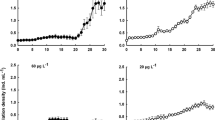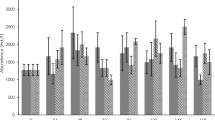Abstract
Linear anionic polyacrylamide (LA-PAM) is being considered as a soil amendment to reduce seepage and infiltration in unlined earthen canals. While polyacrylamides have been extensively used for potable water treatment, dewatering sewage sludge, coal and mine processing, paper manufacturing, and agriculture, little is known about its ecological impact to aquatic ecosystems. Acute toxicity (LC50, 24 and 48 h) and chronic exposure tests (limited and continuous exposures) were conducted on Daphnia magna. In the chronic limited exposure experiments, Daphnia were exposed to LA-PAM for only 24 h whereas for the chronic continuous exposure the concentrations of 0, 0.5, 1, 5, 10, and 100 mg/L were tested and the endpoints of growth, onset to reproduction, fecundity, and mortality were measured for the duration of 32 days. There was no significant difference among the chronic, limitedly exposed organisms. The acute toxicity for LA-PAM was measured at 100, 150, 200, 250, and 300 mg/L. The acute test showed that the LC50 for LA-PAM was at 152 mg/L. Overall in the chronic, continuous exposure test, D. magna was negatively impacted by LA-PAM at levels as low as 1 mg/L. Growth was reduced by 37% and 89% at 1 and 100 mg/L, respectively. Fecundity and onset to reproduction was impaired at 10 and 100 mg/L. Kinematic viscosity ranged from 0.98 cSt at 1 mg/L to 2.9 at 100 mg/L. At these levels, mechanical and physiological impairments due to the viscous properties of LA-PAM are the proposed mechanisms of reduction in the life history traits of D. magna.





Similar content being viewed by others
References
Abrusán, G. (2004). Filamentous cyanobacteria, temperature and Daphnia growth: The role of fluid mechanics. Oecologia, 141, 395–401.
Acharya, K., Kyle, M., & Elser, J. J. (2004). Effects of stoichiometric dietary mixing on Daphnia growth and reproduction. Oecologia, 138, 333–340.
Azzam, R., El-Hady, O. A., Lofty, A. A., & Hegela, M. (1983). San-RAPG combination simulating fertile clayey soils, parts I–IV. International Atomic Energy Agency SM, 267(15), 321–349.
Barber, I., Baird, D. J., & Calow, P. (1990). Clonal variation in general responses of Daphnia magna Straus toxic stress. II. Physiological effects. Functional Ecology, 4, 409–414.
Barvenik, F. W. (1994). Polyacrylamide characteristics related to soil applications. Soil Science, 158, 235–243.
Beim, A. A., & Beim, A. M. (1994). Comparative ecological-toxicological data on determination of maximum permissible concentrations (MPC) for several flocculants. Environmental Technology, 15, 195–198.
Biesinger, K. E., Lemke, A. E., Smith, W. E., & Tyo, R. M. (1976). Comparative toxicity of polyelectrolytes to selected aquatic animals. Journal of the Water Pollution Control Federation, 48, 183–187.
Brennan, S. J., Brougham, C. A., Roche, J. J., & Fogarty, A. M. (2006). Multi-generational effects of four selected environmental oestrogens on Daphnia magna. Chemosphere, 64, 49–55.
Cserháti, T., Forgács, E., & Oros, G. (2002). Biological activity and environmental impact of anionic surfactants. Environment International, 28, 337–348.
DeMott, W. R., Gulati, R. D., & Siewertsen, K. (1998). Effects of phosphorus-deficient diets on the carbon and phosphorus balance of Daphnia magna. Limnology and Oceanography, 43, 1147–1161.
Denny, M. W. (1990). Terrestrial versus aquatic biology—the medium and its message. American Zoologist, 30, 111–121.
Dodson, S. I., & Hanazato, T. (1995). Commentary on effects of anthropogenic and natural organic-chemicals on development, swimming behavior, and reproduction of Daphnia, a key member of aquatic ecosystems. Environmental Health Perspectives, 103, 7–11.
Flickinger, A. L., Bruins, R. J. F., Winner, R. W., & Skillings, J. H. (1982). Filtration and phototactic behavior as indexes of chronic copper stress in Daphnia-Magna Straus. Archives of Environmental Contamination and Toxicology, 11, 457–463.
Friedman, M. (2003). Chemistry, biochemistry, and safety of acrylamide. A review. Journal of Agricultural and Food Chemistry, 51, 4504–4526.
Hamilton, M. A., Russo, R. C., & Thurston, R. V. (1977). Trimmed Spearman–Karber method for estimating median lethal concentrations in toxicity bioassays. Environmental Science and Technology, 117, 714–719. correction, 12, 417(1978).
Hanazato, T. (1998). Growth analysis of Daphnia early juvenile stages as an alternative method to test the chronic effect of chemicals. Chemosphere, 36, 1903–1909.
Herbert, P. D. N., & Crease, T. J. (1980). Clonal coexistence in Daphnia pulex Leydig: another planktonic paradox. Science (Washington, DC, U.S.), 207, 1363–1365.
Kersting, K., & Van der Honing, H. (1981). Effect of the herbicide dichlobenil on the feeding and filtering rate of Daphnia magna. Verh International Verein Limnology, 21, 1135–1140.
LeBlanc, G. A. (1982). Laboratory investigations into the development of resistance of Daphnia magna (Straus) to environmental pollutants. Environmental Pollution Series A, 27, 309–322.
Lentz, R. D. (2003). Inhibiting water infiltration with PAM and surfactants: Applications for irrigated agriculture. Journal of Soil and Water Conservation, 58, 290–300.
Lentz, R. D., & Freeborn, L. L. (2007). Sediment and polyacrylamide effects on seepage from channeled flows. Soil Science, 172, 770–789.
Lentz, R. D., Sojka, R. E., & Mackey, B. E. (2002). Fate and efficacy of polyacrylamide applied in furrow irrigation: Full-advance and continuous treatments. Journal of Environmental Quality, 31, 661–670.
LoPachin, R. M. (2004). The changing view of acrylamide neurotoxicity. Neurotoxicology, 25, 617–630.
MacWilliams, D. C. (1978). Acrylamides. In I. Kirk & D. F. Othmer (Eds.), Encyclopedia of chemical technology, vol. 1 (p. 298). New York: Wiley.
McLaughlin, R. A., & Bartholomew, N. (2007). Soil factors influencing suspended sediment flocculation by polyacrylamide. Soil Science Society of America Journal, 71, 537–544.
Main, T. M., Dobberfuhl, D. R., & Elser, J. J. (1997). N:P stoichiometry and ontogeny of crustacean zooplankton: A test of the growth rate hypothesis. Limnology and Oceanography, 42, 1474–1478.
NSF (National Sanitation Foundation). (2007). Drinking water treatment chemicals-health effects. Ann Arbor: Standard 60–2007 National Sanitation Foundation Ann Arbor.
Podolsky, R. D. (1994). Temperature and water viscosity: Physiological versus mechanical effects on suspension seeding. Science (Washington, DC, U.S.), 265, 100–103.
Rubenstein, D. I., & Koehl, M. A. R. (1977). The mechanisms of filter feeding: Some theoretical considerations. American Naturalist, 111, 981–994.
Stone, M. C., Goreham, J., Chen, L., & Stone, A. B. (2008). Impacts of shear stress on saturated hydraulic conductivity of a polyacrylamide treated soil. ASCE World Environmental and Water Resources Congress. Hawaii: Honolulu. May 12–16.
Susfalk, R. B. (2009). Evaluation of the effectiveness of linear anionic polyacrylamide (LA-PAM) when used to reduce seepage in unlined irrigation canals within the 17 Western States. Reno: DRI Publication, Desert Research Institute.
Susfalk, R. B., Young, M. H., & Smith, D. M. (2007). Application guidelines: use of granular, linear anionic polyacrylamide (LA-PAM) in water delivery canals for seepage control. Desert Research Institute DHS Publication No. 41239. Reno: Desert Research Institute.
Susfalk, R. B., Sada, D., Martin, C., Young, M. H., Gates, T., Rosamond, C., et al. (2008). Evaluation of linear anionic polyacrylamide (LA-PAM) application to water delivery canals for seepage reduction. Desert Research Institute DHS Publication No. 41245. Reno: Desert Research Institute.
Tanji, K. K., & Kielen, N. C. (2002). Agricultural drainage water management in arid and semi-arid areas. FAO Irrigation and Drainage Paper No. 61. Rome, Italy: Food and Agriculture Organization of the United Nations.
Tatarazako, N., & Oda, S. (2007). The water flea Daphnia magna (Crustacea, Cladocera) as a test species for screening and evaluation of chemicals with endocrine disrupting effects on crustaceans. Ecotoxicology, 16, 197–203.
USEPA (US Environmental Protection Agency). (1996). Ecological effects test guidelines: OPPTS 850.1010 aquatic invertebrate acute toxicity test, freshwater daphnids. EPA-712-C-96-114, US Environmental Protection Agency Prevention, Office of Pesticides and Toxic Substances (7101) Washington, DC.
Ward, T. J., & Robinson, W. E. (2005). Evolution of cadmium resistance in Daphnia magna. Environmental Toxicology and Chemistry, 24, 2341–2349.
Wilson, A. D., & Crisp, S. (1975). Rigid highly carboxylated ionic polymers. In L. Holiday (Ed.), Ionic polymers (p. 208). New York: Chapman and Hall.
Young, M. H., Tappen, J. J., Miller, G. C., Carroll, S., & Susfalk, R. B. (2007). Initial risk characterization: using linear anionic polyacrylamide (LA-PAM) to reduce water seepage from unlined water delivery canal systems. Desert Research Institute DHS Publication No. 41226. Las Vegas: Desert Research Institute.
Young, M. H., Moran, E. A., Yu, Z., & Zhu, J. (2009). Reducing saturated hydraulic conductivity of sandy soils with polyacrylamide. Soil Science Society of America Journal, 73, 13–20.
Acknowledgments
The authors gratefully acknowledge funding from the U.S. Bureau of Reclamation under the Water 2025 program, cooperative agreement 04-FC-81-1064. Del Smith was our program manager.
Author information
Authors and Affiliations
Corresponding author
Rights and permissions
About this article
Cite this article
Acharya, K., Schulman, C. & Young, M.H. Physiological Response of Daphnia magna to Linear Anionic Polyacrylamide: Ecological Implications for Receiving Waters. Water Air Soil Pollut 212, 309–317 (2010). https://doi.org/10.1007/s11270-010-0344-x
Received:
Accepted:
Published:
Issue Date:
DOI: https://doi.org/10.1007/s11270-010-0344-x




